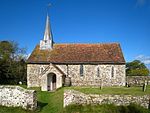Wiggonholt

Wiggonholt is a village and former civil parish, now in the parish of Parham, in the Horsham district of West Sussex, England. It is 1.5 miles (2.4 km) southeast of Pulborough on the A283 road. The village consists of a farm, a few houses and a small Church of England parish church. In 1931 the parish had a population of 54. On 1 April 1933 the parish was abolished and merged with Parham.The RSPB Pulborough Brooks wildfowl reserve is north of the parish church, on the floodplain of the River Arun. Wiggonholt Common is an area of open woodland south of the village that adjoins Parham Park and is popular with walkers. A Roman road, the Greensand Way, from north of Lewes passed north of the village to join Stane Street at Hardham on the west bank of the River Arun. The remains of a Roman bath house have been excavated beside the Roman road.The small rectangular medieval parish church of unknown dedication has a bell turret and Horsham Stone roof, and has a Sussex marble font.
Excerpt from the Wikipedia article Wiggonholt (License: CC BY-SA 3.0, Authors, Images).Wiggonholt
Mare Hill Road,
Geographical coordinates (GPS) Address Nearby Places Show on map
Geographical coordinates (GPS)
| Latitude | Longitude |
|---|---|
| N 50.939 ° | E -0.488 ° |
Address
Mare Hill Road
Mare Hill Road
RH20 2EQ , Parham
England, United Kingdom
Open on Google Maps










